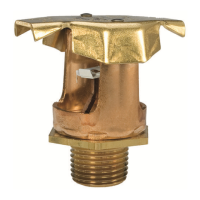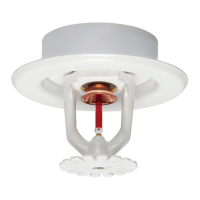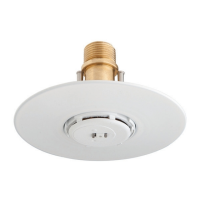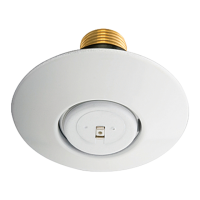TFP610
Page 8 of 28
higher spacing. For example, a 45 feet
(13,7 m) span with the BB1 (K=8.0)
would be calculated at the 60 feet
(18,3 m) span.
For the AP Sprinklers, the minimum
design pressure is 7 psi, and the mini-
mum design density is 0.10 gpm/ft
2
(4,1 mm/min). The NFPA 13, 20 psi (1,4
bar) minimum operating pressure for
Standard Spray Sprinkler spacings
parallel to the ridge that are above 8
feet (2,4 m) does not apply to the AP.
Coverage Area
• Coverage area for the BB (Back to
Back) Sprinklers is determined by
twice the distance of the furthest
throw measured along the slope
multiplied by the distance along
the branchline (maximum distance
along branchline is 6 feet [1,8 m] re-
gardless of the length of the throw).
Note: The distance along the branch-
line may have to be reduced to less
than the maximum of 6 feet (1,8 m) to
remain under 400 ft
2
(37, 2 m
2
) maxi-
mum depending on the slope and the
span. In no case can the span exceed
60 feet (18,3 m) without additional
Standard Spray Sprinklers.
• Coverage area for the SD (Single Di-
rectional) Sprinklers is the distance
along the branchline multiplied
by the distance of the throw down
the slope. Regardless of the throw,
the maximum distance along the
branchline is 6 feet (1,8 m), the max-
imum throw measured horizontally
is 40 feet (12,2 m), and the maxi-
mum coverage per sprinkler is 400
ft
2
(37, 2 m
2
).
• Coverage area for the HIP Sprin-
klers is the distance down the larger
slope multiplied by two, and multi-
plied by the distance between the
sprinklers as measured along the
slope of the hip.
• Coverage area for the AP (Attic Plus)
Sprinklers is the distance along the
branchline multiplied by the dis-
tance between the branchlines. The
maximum spacing is 10 feet (3,1 m)
perpendicular to the slope and 12
feet (3,6 m) parallel to slope, and
as measured on the slope. When
there is more than one row of AP
Sprinklers, the sprinklers must be
staggered per Figure 20-B-3. The
maximum spacing per sprinkler is
120 ft
2
(11,1 m
2
).
Design
Guidelines
To design a project with attic sprin-
klers use these steps as a guideline:
• Determine if single, dual directional
or hip sprinkler is needed.
• Determine the roof slope is between
3:12 to 12:12. If more than one slope
is being used on a project, select
the correct sprinkler for each area.
• Follow the guidelines for each type
of sprinkler.
• Calculate the sprinkler system in ac-
cordance with the appropriate flow
and pressure information provid-
ed in Table A, as well as Figure 20.
There is no interpolation of the flows
and pressures shown on the chart.
For BB Sprinklers
(Back to Back Dual Directional)
• Verify framing direction is perpen-
dicular to outside wall (Ref. Figure
12). If not, cover that area with AP
Sprinklers or Standard Spray Sprin-
klers (Ref. Figure 13).
• Determine the throw needed (see
spacing requirements in Table A).
If over 20 feet (6,1 m) and up to 60
feet (18,3 m) is required, use the 8.0
K-factor, BB Sprinklers to reduce
the pressure required. If pressure
is not a concern, use the 5.6 K-fac-
tor, BB Sprinklers to minimize over
discharge.
• If less than 20 feet (6,1 m) is re-
quired, use the 4.2 K-factor, Back
to Back Dual Directional to minimize
pressure and flow requirements
• Determine the distance along the
slope. If the distance is not equal,
use the longer side. Multiply the lon-
ger side by two to determine the
spacing down the slope. Four hun-
dred divided by this value will de-
termine the maximum spacing
along the ridge. The maximum dis-
tance is 6 feet (1,8 m). For exam-
ple, a 12:12 slope at the maximum
span of 60 feet (18,3 m) will produce
a slope length of approximately 42.5
feet (13,0 m). That number multi-
plied by two produces an 85 feet
(25,9 m) throw. Four hundred square
feet maximum divided by an 85 feet
(25,9 m) throw only allows a 4 feet
8 inches (1,4 m) spacing along the
ridge. Using the maximum spacing,
space the sprinklers along the ridge.
• Avoid obstructions as shown in Fig-
ure 16. If necessary, add Model AP
Sprinklers or Standard Spray Sprin-
klers to maintain coverage around
obstructions.
• BlazeMaster CPVC may be used
exposed to provide wet system,
vertical or angled, sprigs to AP
Sprinklers (Ref. Figures 17A & 17B)
where:
• The exposed portion of an angled
sprig is a maximum length of 3 feet
(0,9 m), the sprig is supported ad-
jacent to the AP Sprinkler, and ver-
tical restraint is provided using the
CPVC hanger support for horizon-
tal pipe runs
•
Vertical sprigs have a maximum
exposed length of 10 feet (3,05
m), the AP Sprinkler is located at
a maximum lateral distance of 12
inches (3304,8 mm) from the sprig
centerline, and the sprig is sup-
ported at the swing joint to the AP
Sprinkler
•
A minimum 6 inches (152,4 mm)
deep of non-combustible insulation
extending 12 inches (304,8 mm) on
each side away from the centerline
of the CPVC branchline feeding the
AP sprigs (Ref. Figure 17A). If the
CPVC branchline is located inside
the ceiling joist, the joist channel
must be covered or lled with a
minimum of 6 inches (152,4 mm)
deep of noncombustible insula-
tion on top of the branchline feed-
ing the AP sprigs (Refer to Figure
17B). Insulation is for re protection
purposes. It is not freeze protec-
tion. Additional depth of non-com-
bustible insulation may be added
to reduce the exposed length of the
AP sprigs.
•
A minimum lateral distance of 18
inches (450 mm) is maintained be-
tween the CPVC pipe and a heat
producing device such as heat
pumps, fan motors, and heat lamps
Mismatched Slopes
Refer to Figure 10.
Obstructions
For BB, SD, and HIP, refer to Figure
16. For AP Sprinklers, refer to Figure
18. BB, SD, HIP, and AP Sprinklers
may be installed directly on maximum
2-1/2 inch NPS (DN65) branch lines
without the need for sprigs. See the
2007 edition of NFPA 13, 8.8.5.2 for
requirements when installed on pipe
greater than 2-1/2 inch NPS (DN65).
Hydraulic Requirements
Refer to Figure 20.
To Determine the Correct Flow and
Pressure
For BB, SD, or HIP Sprinklers, deter-
mine the roof span (measured hori-
zontally) and the slope of the roof, and
then refer to Table A. There is no in-
terpolation of the flow and pressure
shown. Round all cases to the next

